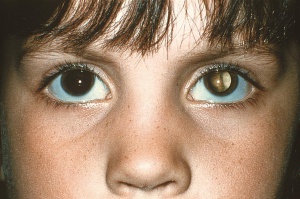Leukocoria: Difference between revisions
Andrew.R.Lee (talk | contribs) No edit summary |
Andrew.R.Lee (talk | contribs) No edit summary |
||
| Line 1: | Line 1: | ||
{{Article | {{Article | ||
|Authors=Sarah.g.chaudhry | |Authors=Sarah.g.chaudhry | ||
|Category=Articles, Pediatric Ophthalmology/Strabismus | |Category=Articles,Pediatric Ophthalmology/Strabismus | ||
|Assigned editor=Andrew.R.Lee | |Assigned editor=Andrew.R.Lee | ||
|Date reviewed= | |Date reviewed=October 17, 2021 | ||
|Article status= | |Article status=Up to Date | ||
|Local Videos={{LocalVideo}} | |||
}} | }} | ||
== '''Definition and Terminology''' == | == '''Definition and Terminology''' == | ||
Leukocoria, meaning “white pupil,” originates from the Greek words “leukos” (white) and “kore” (pupil). It refers to the reflection of white light seen upon direct illumination of the fundus through the pupil, in contrast to the usual red glow.[[File:Retinoblastoma White Reflex.jpeg|thumb|Leukocoria of the right eye due to retinoblastoma]] | Leukocoria, meaning “white pupil,” originates from the Greek words “leukos” (white) and “kore” (pupil). It refers to the reflection of white light seen upon direct illumination of the fundus through the pupil, in contrast to the usual red glow.[[File:Retinoblastoma White Reflex.jpeg|thumb|Leukocoria of the right eye due to retinoblastoma]] | ||
Revision as of 12:13, October 17, 2021
All content on Eyewiki is protected by copyright law and the Terms of Service. This content may not be reproduced, copied, or put into any artificial intelligence program, including large language and generative AI models, without permission from the Academy.
Property "File page" (as page type) with input value "File:" contains invalid characters or is incomplete and therefore can cause unexpected results during a query or annotation process.
Definition and Terminology
Leukocoria, meaning “white pupil,” originates from the Greek words “leukos” (white) and “kore” (pupil). It refers to the reflection of white light seen upon direct illumination of the fundus through the pupil, in contrast to the usual red glow.
Etiopathogenesis
Direct interference of the normal red reflex from opacities and abnormalities occurring anywhere from the crystalline lens through to the posterior pole can create the leukocoric reflex. For example the white retinal mass seen in retinoblastoma creates leukocoria.
Differential Diagnosis[1][2][3]
- Tumors
- Congenital malformations
- Media opacities
- Cataract
- Corneal opacity
- Organizing vitreous hemorrhage
- Retinal detachment
- Vascular diseases
- Inflammatory diseases
- Ocular toxocariasis
- Congenital toxoplasmosis
- Cytomegalovirus retinitis
- Herpes simplex retinitis
- Endophthalmitis
- Uveitis
- Trauma
- Refractive
- High myopia or anisometropia
- Miscellaneous
- Strabismus (Brückner’s phenomenon)
- Photographic artifact
- Pseudoleukocoria due to optic nerve reflex
Diagnosis
History
Comprehensive history should include age of onset, duration, and other ocular symptoms. Past ocular history and past medical history including prematurity, retinopathy of prematurity, trauma, arthritis, prenatal infection, and other systemic diseases should be assessed. Family history of ocular diseases including retinoblastoma, familial exudative vitreoretinopathy, and coloboma should be obtained as well.[1]
Clinical Examination
Red Reflex
Red reflex testing recommendations from the Americn Academy of Pediatrics are as follows:[4]
"All infants should have an examination of the red reflex of the eyes performed during the first 2 months of life by a pediatrician or other primary care clinician trained in this examination technique. This examination should be performed in a darkened room on an infant with his or her eyes open, preferably voluntarily, using a direct ophthalmoscope held close to the examiner’s eye and approximately an arm’s length from the infant’s eyes.... To be considered normal, the red reflex of the 2 eyes should be symmetrical. Dark spots in the red reflex, a blunted red reflex on 1 side, lack of a red reflex, or the presence of a white reflex (retinal reflection) are all indications for referral to an ophthalmologist."
Comprehensive Ophthalmic Examination
In cases of abnormal red reflex, a comprehensive ophthalmic examination is indicated. Anterior segment abnormalities can include microphthalmia, microcornea, persistent pupillary membrane, iris coloboma, cataract, or neovascularization or inflammation. Fundus abnormalities can include vitreous opacities, optic nerve anomalies, retinal vascular abnormalities (in ROP, Coats disease, retinoblastoma, and FEVR), and retinal masses, exudation, detachment, stalk, or fibrosis.
Ancillary Testing
Ancillary testing should be performed as indicated by other findings on the clinical examination. Ultrasonography can help detect calcification in retinoblastoma and can also diagnose findings in other diseases in the above differential diagnosis including Coats disease, PFV, and retinal detachment.[1] Ultrasonography is particularly valuable in cases with media opacities which may prevent direct visualization of the posterior segment.
Other ancillary testing may include fluorescein angiography, optical coherence tomography, or neuroimaging such as computerized tomography or magnetic resonance imaging.
- ↑ Jump up to: 1.0 1.1 1.2 Syed R, Ramasubramanian A. Ophthalmic Pearls: A Stepwise Approach to Leukocoria. EyeNet Magazine. July 2016.
- ↑ Balmer A, Munier F. Differential diagnosis of leukocoria and strabismus, first presenting signs of retinoblastoma. Clin Ophthalmol. 2007;1(4):431-439.
- ↑ American Academy of Ophthalmology. Pediatric Ophthalmology and Strabismus. Basic and Clinical Science Course 2021-2022.
- ↑ American Academy of Pediatrics. "Red Reflex Examination in Infants." Pediatrics May 2002, 109 (5) 980-981; DOI: https://doi.org/10.1542/peds.109.5.980


